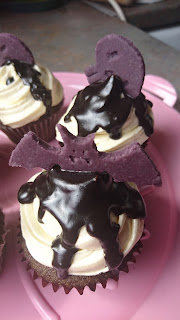Happy World Goth Day, everyone! A day to celebrate the colour black, bats, and everything morbid and macabre!
The first time I wore a completely black outfit, I was about fifteen years old. That was the start of a love affair with the gothic that has never stopped. Once you embrace black, you can't go back! My wardrobe and drawers are populated with black, grey, red, blue, purple, and the odd neon accent; leather, fishnet and opaque coloured tights, tartan, and pirate paraphernalia, too. I started my collection of piercings when I was 17 (12 in total, so far), and my tattoos followed later on at 25. Neither collection is finished.
So, as you can probably guess, Goth Day and Halloween are my favourite times of the year. This year, however, is the first time I've got around to wearing false vampire teeth! When I say teeth, I mean some white false stiletto style fingernails stuck on with denture adhesive. Does the job though!
To celebrate, I made some lovely purple velvet fairy cakes, swirled with buttermilk-spiked cooked milk icing, drizzled in super-black chocolate glaze, and crowned with a marzipan batty-bat.
I made the cakes using my red velvet cake recipe, using two eggs and scaling the other ingredients down accordingly, and using purple food colouring instead of red; this amount made 12 cakes. I topped off the cakes with the same icing as the red velvet cake too, only I used half the amount.
The chocolate glaze was made using 2 ounces (55 grammes) dark chocolate, 1 ounce (30 grammes) butter, half a tablespoon of black liquid food colouring, and half a tablespoon of milk. I melted all these ingredients together in a bowl in the microwave, heating for 15 seconds at a time and stirring between. I allowed it to cool down enough to pour over the icing swirls without melting it.
I coloured some marzipan purple, rolled it out to roughly a quarter inch (5 millimetres), and cut out bats and skulls. I drew the designs freehand on some card and cut out them out to make the templates.
The outside crusts of the cakes aren't very purple, I must admit. But the insides are suitably luminous! I was very pleased with how these turned out, and I'm even more pleased about the Goth ensemble with false teefs!
THIS TIME IN 2016: Mocha Cupcakes: Chocolate and Coffee Join Forces (Gluten Free; Dairy Free Option)
THIS TIME IN 2015: Super Moist and Rich Chocolate Cake
THIS TIME IN 2013: Coconut Custard Creams (Wheat Free)
There was no blog this time in 2014.










































